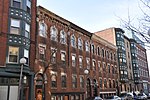Ruggles station

Ruggles station is an intermodal transfer station in Boston, Massachusetts. It serves MBTA rapid transit, bus, and commuter rail services and is located at the intersection of Ruggles and Tremont streets, where the Roxbury, Fenway–Kenmore, and Mission Hill neighborhoods meet. It is surrounded by the campus of Northeastern University. Ruggles is a station stop for the Orange Line subway, as well as the Providence/Stoughton Line, Franklin Line, and Needham Line of the MBTA Commuter Rail system. Thirteen bus routes stop at Ruggles, including four of the fifteen key MBTA bus routes. The entire Orange Line, including the Orange Line platforms at Ruggles station, will be closed from August 19 to September 18, 2022, during maintenance work. Commuter Rail and bus service to the station will not be affected.
Excerpt from the Wikipedia article Ruggles station (License: CC BY-SA 3.0, Authors, Images).Ruggles station
Huntington Avenue, Boston Fenway / Kenmore
Geographical coordinates (GPS) Address Website Nearby Places Show on map
Geographical coordinates (GPS)
| Latitude | Longitude |
|---|---|
| N 42.3362 ° | E -71.0895 ° |
Address
Northeastern University
Huntington Avenue 360
02115 Boston, Fenway / Kenmore
Massachusetts, United States
Open on Google Maps






